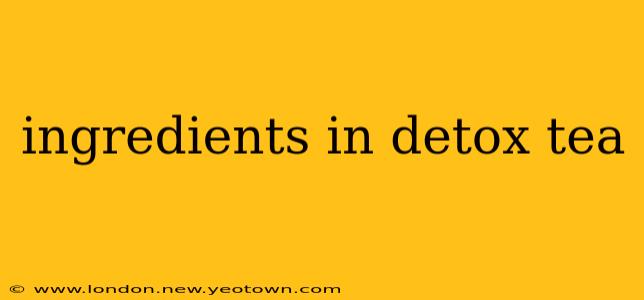Detox teas. The very name conjures images of cleansing, rejuvenation, and a healthier you. But what exactly is in these popular beverages, and do they truly live up to the hype? Let's embark on a journey to unravel the mysteries within those tea bags. It's a story filled with surprising botanicals, potential benefits, and a healthy dose of reality.
Our story begins, not surprisingly, with tea itself. Many detox teas base themselves on the robust foundation of black tea, green tea, or white tea. Each offers its own unique profile of antioxidants, contributing to the overall "detoxifying" effect often touted by brands. But the real action often comes from the supporting cast of ingredients.
What are the common ingredients in detox teas?
This is where the story gets interesting. While the exact blend varies wildly between brands, several ingredients frequently appear. These botanical stars often play a key role in the purported detox benefits. Let's shine a light on some of the most common players:
1. Senna:
This is a powerful laxative derived from a plant. It's often the primary driver of the bowel-clearing effects many associate with detox teas. However, overuse can lead to dependency and other digestive issues. It's a potent ingredient, so moderation is key!
2. Dandelion Root:
Often hailed as a gentle diuretic, dandelion root helps your body flush out excess water weight. It's a milder approach to detoxification, often seen as a more sustainable addition to a healthy lifestyle. Think of it as the supportive friend to senna's more forceful action.
3. Ginger:
Known for its anti-inflammatory properties, ginger adds a spicy kick and potential digestive benefits to the mix. It's a comforting addition to a detox blend, soothing the stomach while contributing to overall well-being.
4. Lemon Balm:
This herb offers a calming and uplifting effect, potentially reducing stress and improving sleep. While not directly involved in detoxification in the same way as other ingredients, it adds to the holistic approach many detox teas aim for.
5. Hibiscus:
This tart and vibrant flower boasts antioxidants and adds a visually appealing splash of color to the tea. Its refreshing taste makes it a popular addition to many blends.
Do detox teas really work?
This is a question that demands careful consideration. While the ingredients often included can have beneficial effects on the body, the idea of a quick "detox" is often overblown. Your liver and kidneys are already highly efficient at eliminating toxins. These teas can support these natural processes, particularly in terms of hydration and bowel regularity. But they are not a magic bullet.
What are the potential side effects of detox tea?
The potential side effects of detox tea largely hinge on the specific ingredients and the frequency of consumption. Senna, as mentioned before, can cause dependency and digestive upset if consumed excessively. Some individuals may also experience mild side effects like headaches or dizziness. It's crucial to listen to your body and moderate your intake.
Are detox teas safe for everyone?
No. Detox teas are not universally safe. Pregnant women, breastfeeding mothers, individuals with underlying health conditions (especially those affecting the digestive system or kidneys), and people taking certain medications should consult their doctor before consuming detox tea.
Can I make my own detox tea?
Absolutely! Once you understand the individual ingredients, you can create your own customized blends. However, always start with small quantities and monitor your body's response carefully. It's advisable to conduct thorough research on the specific herbs and their potential interactions before experimenting.
The story of detox teas is one of both promise and caution. While they can contribute to a healthier lifestyle through hydration and the inclusion of beneficial ingredients, it's crucial to approach them with realistic expectations and mindful consumption. They are a supporting player, not the leading actor, in the grand narrative of a healthy life.

